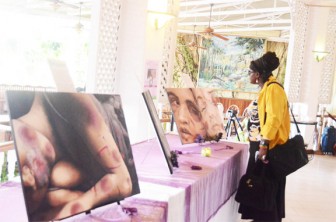The Caribbean America Domes-tic Violence Awareness (CADVA) last weekend wrapped up its two weeks of activities with the hosting of a one-day exhibition at the Pegasus of paintings depicting domestic violence.
The new organisation, which came to these shores on March 1, was recently launched in Orlando, Florida and aims to educate domestic violence victims on how to speak out on the issue by conducting empowerment sessions.
The exhibition was first launched in Berbice under the theme ‘Reflections: Faces of domestic violence Pt 1’. The paintings, done by Carl Anderson, were inspired by Dianne Madray of the Irene Madray Recreational Arts and Resources Centre (IMRARC).

Madray along with Sukree Boodram, both of whom were part of the Break the Silence, Say No to Domestic Violence Group, formed CADVA along with others.
Speaking to Sunday Stabroek, Madray said that each painting tells a story. She said Anderson is just the first artist in the series since she has secured the services of other artists who are going to be part of future exhibitions. The paintings were done from photographs which were manipulated to depict abuse and while some photographs were done by her, others were taken from local media. Each painting tells a story which transforms the image beyond what the naked eyes see in the painting.
She said the next artist will create using a religious theme and from what she has been hearing, the artist is going to transform some of the stories into a religious context onto canvas to show the historical perspective of domestic violence.
“We need to look at that because before we can come to the root of the cause we have to look at it from a historic perspective and to move on,” Madray said.
The paintings were also part of a workshop CADVA hosted in Berbice that focused on trauma and abuse and she said it was powerful as persons came out and shared stories about experiencing abuse when they were children. She said often no emphasis is placed on what happens between childhood to when a person attains adulthood, noting that trauma transcends that period and releasing it is an ongoing process.
The spotlight is going to be placed on this when paintings focusing on the
cultural aspect of domestic violence are created.
Meanwhile, Boodram revealed
that CADVA would be piloted only in Berbice for the next two years, since it is an emerging organization. The Break the Silence message now in its third year,
is being spread under this new organisation. Boodram said she is also familiar with Berbice since it is where she
was born. Noting that there is a large Indian Guyanese presence in Berbice,
she added, and “whether we have it
statistically tracked or not, East Indian communities have a higher percentage of domestic violence.”
She said this is so because of cultural and generational thinking and because persons are ashamed to speak out. But while persons attempt to hide violence of various forms in their homes, it is a secret that is known by their neighbours, Boodram said adding that the messages do not protect a secret that is not a secret and do not protect the abuser.
“We want to educate, empower and let the community understand what is abuse,” Boodram said pointing out that while work is being done in Georgetown, some rural communities are not being sensitized. Requests have already been made for CADVA to do work in some of the Amerindian areas and Boodram said funding will “make CADVA walk the walk, faster….” She said it is a “living breathing” organisation which needs to operate like a corporation and it is going to be “on the platform for ever, it isn’t going anywhere.”
“We have seen… an increased vocal language on domestic violence, not only people just talking the talk but also people sharing their stories and we are seeing more and more of that,” Boodram said.
Boodram said the response in Berbice to the association’s activities exceeded her expectations as about 700 persons attended the various workshops held. But more importantly, she said, about 20% of the attendees shared information on the topic that many still have a difficulty discussing. Another 5% of the persons broke their silence on domestic violence.
CADVA aims to bring open discussion sessions to targeted communities with a view to educating them on how to walk away from abuse, where to go for help, how to stay safe in an abusive situation, how to protect their children and loved ones and how to obtain help, both emotionally and financially.
It is envisaged that the organisation will partner with trained and licensed professionals, past victims who have survived abuse, help agencies, law enforcement, government agencies, non-governmental organizations and even former abusers who have recovered, along with others who collectively will provide the necessary help for victims and their families.
Later in the year, the organisation will target a demographic youth audience with a pre-planned programme by Madray while they would be looking at two locations for the organization.
She said while she can open an office tomorrow what the organisation brings to the community needs to be explored and to ensure that it will be “long lasting and not a fly by night.
“I am not a fly-by-night girl. I am a permanent girl. I’m here to stay and if I say something I am going to do it,” Boodram said.
In the interim the organisation is in the process of developing some public service messages.
On April 9 the organisation will be at the New York University speaking specifically to youths. CADVA members will also meet officers of the New York District Attorney to obtain a space at their facility and representation in their offices.
The organisation will also be in Florida for a weekend in June during the celebration of Caribbean Heritage Month.
Jamaica and Trinidad are also going to be visited by members of the organisation during this year.




